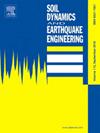隧道入口动力学的理论见解:SV波对地震分区和结构应变的影响
IF 4.2
2区 工程技术
Q1 ENGINEERING, GEOLOGICAL
引用次数: 0
摘要
隧道入口受边坡几何形状和破碎围岩的影响,是其抗震性能的脆弱点。为了研究单面边坡在SV波作用下的动力响应,基于波动动力学原理和射线理论,推导了单面边坡在SV波作用下的位移波场。建立了考虑隧洞与围岩相互作用的隧洞弹性基础梁模型。推导了环向应变和纵向应变的解析表达式,并考察了坡角、地震波长、频率和弹性地基模量的影响。通过分析垂直入射SV波作用下的应变极值分布,确定了隧道洞口的地震薄弱点。主要发现如下:在SV波入射下,拱顶和倒拱的环向应变响应显著高于拱肩、足部和腰部,拱顶和倒拱被确定为地震薄弱环节;与SH波相比,SV波由于波的变换导致应变峰位移,从而导致沿隧道纵轴的损伤位置发生变化。隧道洞口处应变分布呈现双峰特征,垂直入射SH波作用下洞口截面的抗震配筋分区仍然有效。本文章由计算机程序翻译,如有差异,请以英文原文为准。
Theoretical insights into tunnel portal dynamics: effects of SV waves on seismic partitioning and structural strain
The tunnel portal, influenced by the slope geometry and the fractured surrounding rock, constitutes a vulnerable point in terms of seismic resistance. To investigate its dynamic response under SV waves, we derive the displacement wave field for a single-sided slope subjected to SV wave incidence, based on the principles of wave dynamics and Ray theory. An elastic foundation beam model for the tunnel portal is developed, accounting for the interaction between the tunnel and the surrounding rock. Analytical expressions for the hoop and longitudinal strains are derived, and the effects of the slope angle, seismic wavelength, frequency, and elastic foundation modulus are examined. By analyzing the distribution of strain extrema under vertically incident SV waves, we identify the seismic weak points of the tunnel portal. Key findings include the following: under SV wave incidence, the hoop strain response at the crown and inverted arch is significantly higher than at the spandrel, foot, and waist, with the crown and inverted arch identified as the seismic weak points. In contrast to SH waves, SV waves cause a shift in the strain peak due to wave transformation, leading to variations in the damage locations along the tunnel's longitudinal axis. The strain distribution at the tunnel portal exhibits a bimodal characteristic, and the seismic reinforcement zoning for the portal section under vertically incident SH waves remains valid.
求助全文
通过发布文献求助,成功后即可免费获取论文全文。
去求助
来源期刊

Soil Dynamics and Earthquake Engineering
工程技术-地球科学综合
CiteScore
7.50
自引率
15.00%
发文量
446
审稿时长
8 months
期刊介绍:
The journal aims to encourage and enhance the role of mechanics and other disciplines as they relate to earthquake engineering by providing opportunities for the publication of the work of applied mathematicians, engineers and other applied scientists involved in solving problems closely related to the field of earthquake engineering and geotechnical earthquake engineering.
Emphasis is placed on new concepts and techniques, but case histories will also be published if they enhance the presentation and understanding of new technical concepts.
 求助内容:
求助内容: 应助结果提醒方式:
应助结果提醒方式:


